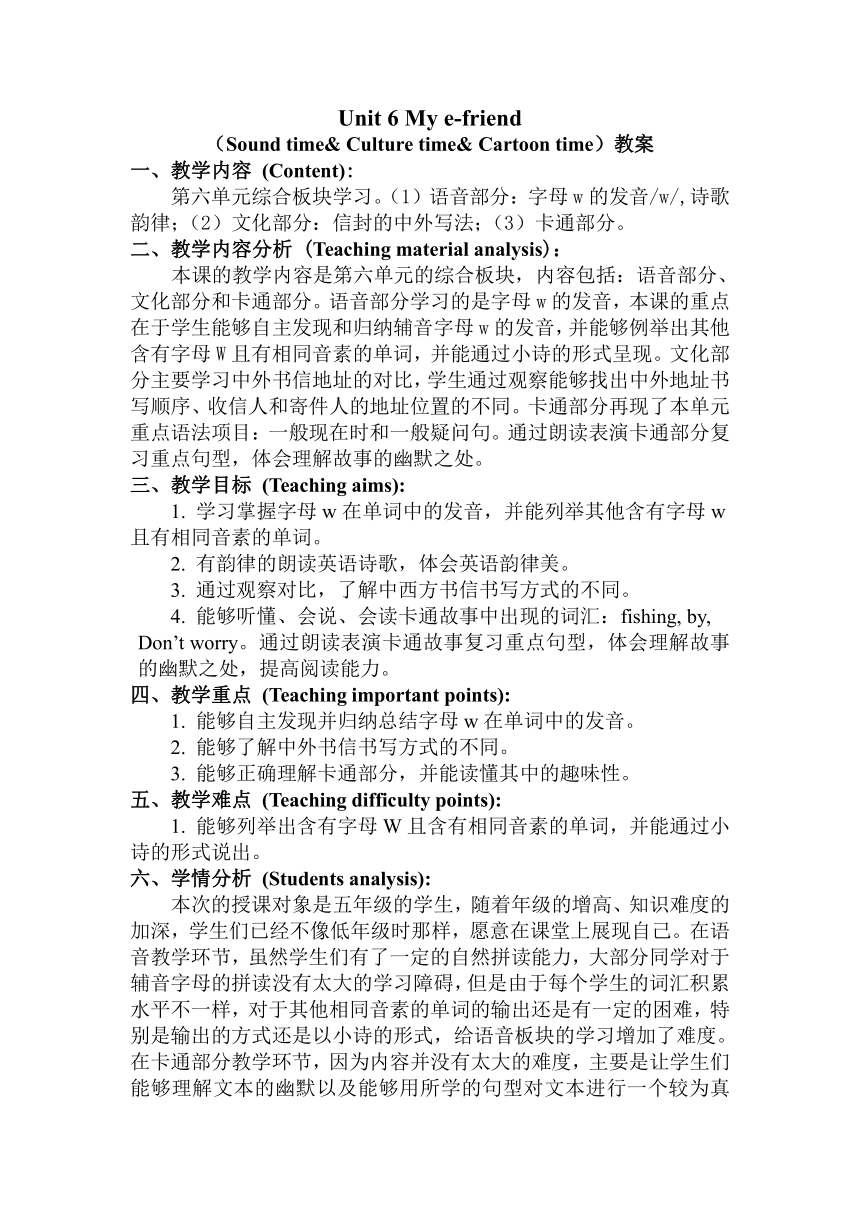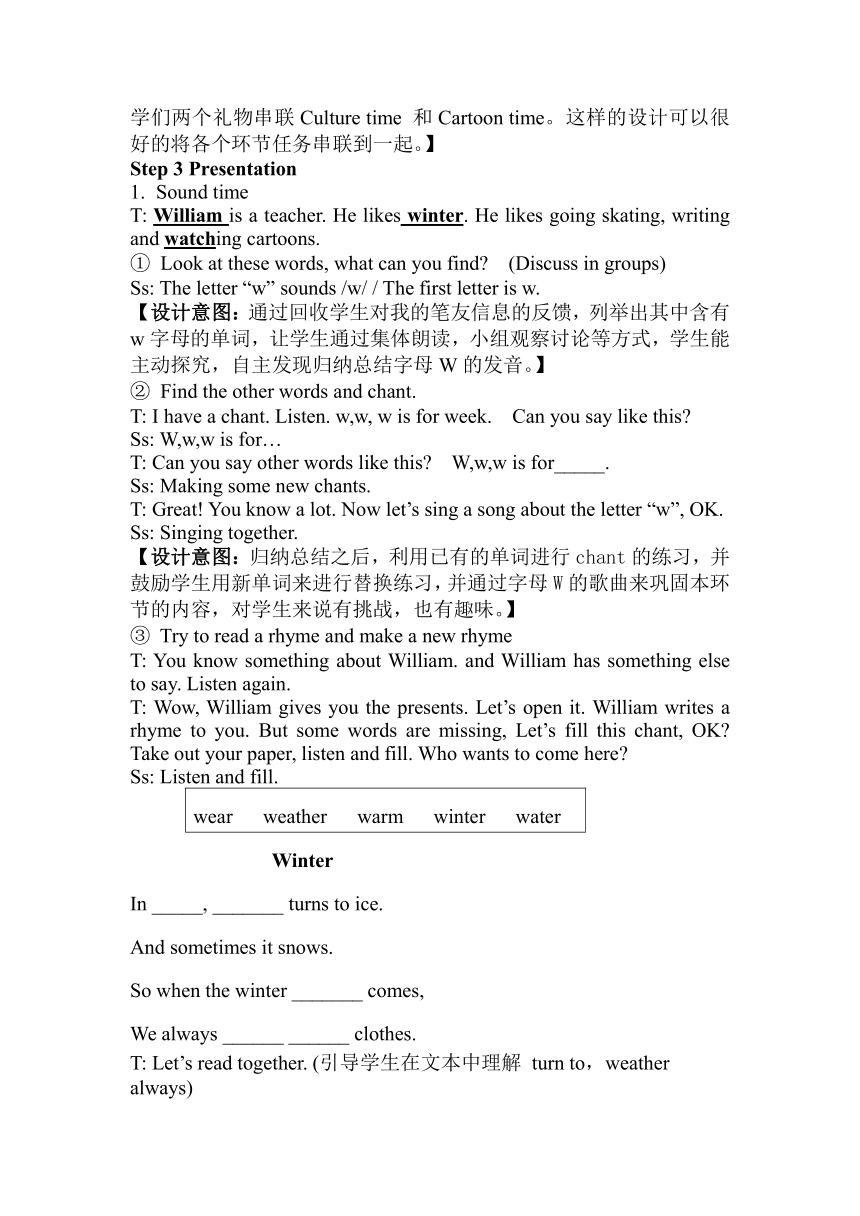Unit 6 My e-friend Sound time& Culture time& Cartoon time 教案(含设计意图)
文档属性
| 名称 | Unit 6 My e-friend Sound time& Culture time& Cartoon time 教案(含设计意图) |  | |
| 格式 | docx | ||
| 文件大小 | 83.4KB | ||
| 资源类型 | 教案 | ||
| 版本资源 | 牛津译林版 | ||
| 科目 | 英语 | ||
| 更新时间 | 2021-12-01 11:19:26 | ||
图片预览



文档简介
Unit 6 My e-friend
(Sound time& Culture time& Cartoon time)教案
一、教学内容 (Content):
第六单元综合板块学习。(1)语音部分:字母w的发音/w/,诗歌韵律;(2)文化部分:信封的中外写法;(3)卡通部分。
二、教学内容分析 (Teaching material analysis):
本课的教学内容是第六单元的综合板块,内容包括:语音部分、文化部分和卡通部分。语音部分学习的是字母w的发音,本课的重点在于学生能够自主发现和归纳辅音字母w的发音,并能够例举出其他含有字母W且有相同音素的单词,并能通过小诗的形式呈现。文化部分主要学习中外书信地址的对比,学生通过观察能够找出中外地址书写顺序、收信人和寄件人的地址位置的不同。卡通部分再现了本单元重点语法项目:一般现在时和一般疑问句。通过朗读表演卡通部分复习重点句型,体会理解故事的幽默之处。
三、教学目标 (Teaching aims):
1. 学习掌握字母w在单词中的发音,并能列举其他含有字母w且有相同音素的单词。
2. 有韵律的朗读英语诗歌,体会英语韵律美。
3. 通过观察对比,了解中西方书信书写方式的不同。
4. 能够听懂、会说、会读卡通故事中出现的词汇:fishing, by,
Don’t worry。通过朗读表演卡通故事复习重点句型,体会理解故事的幽默之处,提高阅读能力。
四、教学重点 (Teaching important points):
1. 能够自主发现并归纳总结字母w在单词中的发音。
2. 能够了解中外书信书写方式的不同。
3. 能够正确理解卡通部分,并能读懂其中的趣味性。
五、教学难点 (Teaching difficulty points):
1. 能够列举出含有字母W且含有相同音素的单词,并能通过小诗的形式说出。
六、学情分析 (Students analysis):
本次的授课对象是五年级的学生,随着年级的增高、知识难度的加深,学生们已经不像低年级时那样,愿意在课堂上展现自己。在语音教学环节,虽然学生们有了一定的自然拼读能力,大部分同学对于辅音字母的拼读没有太大的学习障碍,但是由于每个学生的词汇积累水平不一样,对于其他相同音素的单词的输出还是有一定的困难,特别是输出的方式还是以小诗的形式,给语音板块的学习增加了难度。在卡通部分教学环节,因为内容并没有太大的难度,主要是让学生们能够理解文本的幽默以及能够用所学的句型对文本进行一个较为真实的交际表演,这对于本班学生来说是一个小小的挑战,很多同学羞于用英语和丰富的肢体语言来表演。所以在平时的课堂上,我会树立他们的自信心和自豪感,多给予他们成功的体验。
七、英语和信息技术的融合 (the fusion of English and informational technique):
本节课我使用希沃白板5设计教学课件,简单直观,可以轻松地实现教学想法,在寓教于乐的环境中演绎知识的魅力,完成有趣的互动教学。在课堂导入环节,我使用了蒙层功能,蒙层效果的设计主要是想回收学生有效的课堂信息,便于学生进行语音的归类总结。在核心推进环节中,我使用了课堂游戏配对活动,轻松创建互动课堂,优化课堂反馈。在学生编写小诗环节,我使用了希沃授课助手,将手机秒变成“移动投影仪”,将学生写的小诗以投屏的形式呈现在屏幕上,起到了检查、反馈的作用,也激发了学生的荣誉感。最后的总结环节,我使用了白板中的“思维导图”,让学生能够更加清晰地回顾本单元的知识重点,起到突出重点的作用。
八、教学过程 (Teaching process):
Step 1 Warming-up
T: Good morning, boys and girls.
Ss: Good morning, Miss Zhang.
Step 2 Lead-in
T: Last week, we learn the story time of Unit 6 My e-friend. Who is Wang Bing’s e-friend
S1: He’s Peter.
T: Yes. Do you have any e-friends
Ss: Yes.
T: How do you chat with your e-friends
Ss: On the Internet/ on QQ/We Chat…
T: Do you have any penfriends
Ss: No.
T: I have a penfriend. Look, he’s a handsome boy. Do you have any questions about him What questions
Ss: What’s his name /Where’s he from / What does he do /What season does he like /What does he like doing ...
T: OK. Listen carefully and find the answers.
Ss: 从文本信息中,找到笔友的信息。
【设计意图:语音教学板块不像Story time或者Cartoon time那么有剧情、有趣味性,所以如果不设计一个主情境贯穿三个环节,那么会使整节课变得机械无趣,层次不清晰。所以我通过Story time中王兵网友这个话题转到我的笔友,通过介绍我的笔友William获取更多信息,回收有关字母W的相关单词以及六一儿童节William赠送给同学们两个礼物串联Culture time 和Cartoon time。这样的设计可以很好的将各个环节任务串联到一起。】
Step 3 Presentation
Sound time
T: William is a teacher. He likes winter. He likes going skating, writing and watching cartoons.
① Look at these words, what can you find (Discuss in groups)
Ss: The letter “w” sounds /w/ / The first letter is w.
【设计意图:通过回收学生对我的笔友信息的反馈,列举出其中含有w字母的单词,让学生通过集体朗读,小组观察讨论等方式,学生能主动探究,自主发现归纳总结字母W的发音。】
② Find the other words and chant.
T: I have a chant. Listen. w,w, w is for week. Can you say like this
Ss: W,w,w is for…
T: Can you say other words like this W,w,w is for_____.
Ss: Making some new chants.
T: Great! You know a lot. Now let’s sing a song about the letter “w”, OK.
Ss: Singing together.
【设计意图:归纳总结之后,利用已有的单词进行chant的练习,并鼓励学生用新单词来进行替换练习,并通过字母W的歌曲来巩固本环节的内容,对学生来说有挑战,也有趣味。】
③ Try to read a rhyme and make a new rhyme
T: You know something about William. and William has something else to say. Listen again.
T: Wow, William gives you the presents. Let’s open it. William writes a rhyme to you. But some words are missing, Let’s fill this chant, OK Take out your paper, listen and fill. Who wants to come here
Ss: Listen and fill.
wear weather warm winter water
Winter
In _____, _______ turns to ice.
And sometimes it snows.
So when the winter _______ comes,
We always ______ ______ clothes.
T: Let’s read together. (引导学生在文本中理解 turn to,weather
always)
T: This is William’s rhyme. Can you write a new rhyme for him (Discuss in groups)
Ss: Writing and reading.
____________
In _____, _______________.
And sometimes it ________.
So when the ________ weather comes,
We always ____________________.
【设计意图:本环节是学习语音部分的chant的环节,以William送
一首小诗为话题,学习小诗的结构和小诗中的生词,并让学生们以
自己喜欢的季节写首新诗作为答谢寄给William,不仅培养了学生写的能力,又为下个环节的书信的书写方式埋下了伏笔。】
Culture time
T: Let’s put your rhymes in the envelope, we have an envelope, a stamp, can we send it to William What’s missing
Ss: Addresses.
T: Yes, we should write his addresses on it. They’re addresses. Which one would we write first Please discuss with your partners. Who knows
Ss: Try to find how to write English addresses.
T: Can we write Chinese addresses like this
S: No.
T: Let’s have a look. We write Chinese addresses like this. Look at them, what can you find
Ss: Try to find the differences between Chinese addresses and English addresses.
T: 帮助学生一起梳理中西方书信写法的不同之处。
T: After class, we will send it to William.
T: In fact, many years ago, we wrote a letter to make friends, but now we don’t. We chat on QQ, WeChat and so on. We often contact with friends, because friends are important to us.
【设计意图:通过给William回信这样的情境设计,自然导入书信的写法,通过学生们的讨论,给William的地址进行排序,已经“我”的地址的位置摆放,让同学们对写英语地址有个初步的认识。通过对中文地址的对比,找出中西方书信写法的不同方式,了解中文文化的差异,并鼓励学生们多交朋友。】
Cartoon time
T: Then, let’s open the next one. What’s this
S: A VCD.
① Watch the cartoon and answer
T: What’s the VCD about Let’s watch it.
S: It’s about Bobby and Sam.
T: What will they do
S: They will go fishing. (学习fishing)
② Read and judge
T: What happened to them Now, please read and judge.
( ) 1. Bobby and Sam go fishing today.
( ) 2. Sam is good at fishing.
( ) 3. Bobby has many fish.
③ Read and imitate
T: Let’s read together.
Ss: Reading.
T: How’s Bobby Who can read sadly /How is fish
Who can read angrily
Ss: Try to imitate.
T: Look at the picture. Sam has a lot of fish. But Bobby doesn’t have any. Why
Ss: Try to say something.
T: What do the fish eat
Ss: Earthworm, grass, little fish.
T: You know a lot, I think you can get many fish too. So common sense of life is very important.
T: OK, Show time. Please read and act. You can choose one to act, OK
Ss: Act in groups.
T: Well done. You’re all good actors. Do you like these presents from William
S: Yes.
T: I think he will be happy to hear that.
【设计意图:通过打开William送的第二个礼物,导出卡通部分的学习,通过看-回答问题;读-判断进一步学习卡通内容,并了解为什么Bobby没有钓到鱼的原因。通过这一常识性的问题告诉学生,生活常识对我们非常的重要。通过对卡通部分的表演,培养小组合作的意识和用语言进行较为真实交际的作用。】
Step 3 Consolidation
T: Boys and girls, what do we learn today (思维导图)
Ss: 回顾今天的学习内容。
【设计意图:通过思维导图的形式,让学生更加清晰地回顾本节课所学的内容,有利于学生对所学知识进行分类、总结和提炼。】
Step 4 Homework
1. Try to find more words with the letter "w",and make a new chant.
2. Try to write a letter to William's students.
3. Act the story with your classmates.
Design:
(Sound time& Culture time& Cartoon time)教案
一、教学内容 (Content):
第六单元综合板块学习。(1)语音部分:字母w的发音/w/,诗歌韵律;(2)文化部分:信封的中外写法;(3)卡通部分。
二、教学内容分析 (Teaching material analysis):
本课的教学内容是第六单元的综合板块,内容包括:语音部分、文化部分和卡通部分。语音部分学习的是字母w的发音,本课的重点在于学生能够自主发现和归纳辅音字母w的发音,并能够例举出其他含有字母W且有相同音素的单词,并能通过小诗的形式呈现。文化部分主要学习中外书信地址的对比,学生通过观察能够找出中外地址书写顺序、收信人和寄件人的地址位置的不同。卡通部分再现了本单元重点语法项目:一般现在时和一般疑问句。通过朗读表演卡通部分复习重点句型,体会理解故事的幽默之处。
三、教学目标 (Teaching aims):
1. 学习掌握字母w在单词中的发音,并能列举其他含有字母w且有相同音素的单词。
2. 有韵律的朗读英语诗歌,体会英语韵律美。
3. 通过观察对比,了解中西方书信书写方式的不同。
4. 能够听懂、会说、会读卡通故事中出现的词汇:fishing, by,
Don’t worry。通过朗读表演卡通故事复习重点句型,体会理解故事的幽默之处,提高阅读能力。
四、教学重点 (Teaching important points):
1. 能够自主发现并归纳总结字母w在单词中的发音。
2. 能够了解中外书信书写方式的不同。
3. 能够正确理解卡通部分,并能读懂其中的趣味性。
五、教学难点 (Teaching difficulty points):
1. 能够列举出含有字母W且含有相同音素的单词,并能通过小诗的形式说出。
六、学情分析 (Students analysis):
本次的授课对象是五年级的学生,随着年级的增高、知识难度的加深,学生们已经不像低年级时那样,愿意在课堂上展现自己。在语音教学环节,虽然学生们有了一定的自然拼读能力,大部分同学对于辅音字母的拼读没有太大的学习障碍,但是由于每个学生的词汇积累水平不一样,对于其他相同音素的单词的输出还是有一定的困难,特别是输出的方式还是以小诗的形式,给语音板块的学习增加了难度。在卡通部分教学环节,因为内容并没有太大的难度,主要是让学生们能够理解文本的幽默以及能够用所学的句型对文本进行一个较为真实的交际表演,这对于本班学生来说是一个小小的挑战,很多同学羞于用英语和丰富的肢体语言来表演。所以在平时的课堂上,我会树立他们的自信心和自豪感,多给予他们成功的体验。
七、英语和信息技术的融合 (the fusion of English and informational technique):
本节课我使用希沃白板5设计教学课件,简单直观,可以轻松地实现教学想法,在寓教于乐的环境中演绎知识的魅力,完成有趣的互动教学。在课堂导入环节,我使用了蒙层功能,蒙层效果的设计主要是想回收学生有效的课堂信息,便于学生进行语音的归类总结。在核心推进环节中,我使用了课堂游戏配对活动,轻松创建互动课堂,优化课堂反馈。在学生编写小诗环节,我使用了希沃授课助手,将手机秒变成“移动投影仪”,将学生写的小诗以投屏的形式呈现在屏幕上,起到了检查、反馈的作用,也激发了学生的荣誉感。最后的总结环节,我使用了白板中的“思维导图”,让学生能够更加清晰地回顾本单元的知识重点,起到突出重点的作用。
八、教学过程 (Teaching process):
Step 1 Warming-up
T: Good morning, boys and girls.
Ss: Good morning, Miss Zhang.
Step 2 Lead-in
T: Last week, we learn the story time of Unit 6 My e-friend. Who is Wang Bing’s e-friend
S1: He’s Peter.
T: Yes. Do you have any e-friends
Ss: Yes.
T: How do you chat with your e-friends
Ss: On the Internet/ on QQ/We Chat…
T: Do you have any penfriends
Ss: No.
T: I have a penfriend. Look, he’s a handsome boy. Do you have any questions about him What questions
Ss: What’s his name /Where’s he from / What does he do /What season does he like /What does he like doing ...
T: OK. Listen carefully and find the answers.
Ss: 从文本信息中,找到笔友的信息。
【设计意图:语音教学板块不像Story time或者Cartoon time那么有剧情、有趣味性,所以如果不设计一个主情境贯穿三个环节,那么会使整节课变得机械无趣,层次不清晰。所以我通过Story time中王兵网友这个话题转到我的笔友,通过介绍我的笔友William获取更多信息,回收有关字母W的相关单词以及六一儿童节William赠送给同学们两个礼物串联Culture time 和Cartoon time。这样的设计可以很好的将各个环节任务串联到一起。】
Step 3 Presentation
Sound time
T: William is a teacher. He likes winter. He likes going skating, writing and watching cartoons.
① Look at these words, what can you find (Discuss in groups)
Ss: The letter “w” sounds /w/ / The first letter is w.
【设计意图:通过回收学生对我的笔友信息的反馈,列举出其中含有w字母的单词,让学生通过集体朗读,小组观察讨论等方式,学生能主动探究,自主发现归纳总结字母W的发音。】
② Find the other words and chant.
T: I have a chant. Listen. w,w, w is for week. Can you say like this
Ss: W,w,w is for…
T: Can you say other words like this W,w,w is for_____.
Ss: Making some new chants.
T: Great! You know a lot. Now let’s sing a song about the letter “w”, OK.
Ss: Singing together.
【设计意图:归纳总结之后,利用已有的单词进行chant的练习,并鼓励学生用新单词来进行替换练习,并通过字母W的歌曲来巩固本环节的内容,对学生来说有挑战,也有趣味。】
③ Try to read a rhyme and make a new rhyme
T: You know something about William. and William has something else to say. Listen again.
T: Wow, William gives you the presents. Let’s open it. William writes a rhyme to you. But some words are missing, Let’s fill this chant, OK Take out your paper, listen and fill. Who wants to come here
Ss: Listen and fill.
wear weather warm winter water
Winter
In _____, _______ turns to ice.
And sometimes it snows.
So when the winter _______ comes,
We always ______ ______ clothes.
T: Let’s read together. (引导学生在文本中理解 turn to,weather
always)
T: This is William’s rhyme. Can you write a new rhyme for him (Discuss in groups)
Ss: Writing and reading.
____________
In _____, _______________.
And sometimes it ________.
So when the ________ weather comes,
We always ____________________.
【设计意图:本环节是学习语音部分的chant的环节,以William送
一首小诗为话题,学习小诗的结构和小诗中的生词,并让学生们以
自己喜欢的季节写首新诗作为答谢寄给William,不仅培养了学生写的能力,又为下个环节的书信的书写方式埋下了伏笔。】
Culture time
T: Let’s put your rhymes in the envelope, we have an envelope, a stamp, can we send it to William What’s missing
Ss: Addresses.
T: Yes, we should write his addresses on it. They’re addresses. Which one would we write first Please discuss with your partners. Who knows
Ss: Try to find how to write English addresses.
T: Can we write Chinese addresses like this
S: No.
T: Let’s have a look. We write Chinese addresses like this. Look at them, what can you find
Ss: Try to find the differences between Chinese addresses and English addresses.
T: 帮助学生一起梳理中西方书信写法的不同之处。
T: After class, we will send it to William.
T: In fact, many years ago, we wrote a letter to make friends, but now we don’t. We chat on QQ, WeChat and so on. We often contact with friends, because friends are important to us.
【设计意图:通过给William回信这样的情境设计,自然导入书信的写法,通过学生们的讨论,给William的地址进行排序,已经“我”的地址的位置摆放,让同学们对写英语地址有个初步的认识。通过对中文地址的对比,找出中西方书信写法的不同方式,了解中文文化的差异,并鼓励学生们多交朋友。】
Cartoon time
T: Then, let’s open the next one. What’s this
S: A VCD.
① Watch the cartoon and answer
T: What’s the VCD about Let’s watch it.
S: It’s about Bobby and Sam.
T: What will they do
S: They will go fishing. (学习fishing)
② Read and judge
T: What happened to them Now, please read and judge.
( ) 1. Bobby and Sam go fishing today.
( ) 2. Sam is good at fishing.
( ) 3. Bobby has many fish.
③ Read and imitate
T: Let’s read together.
Ss: Reading.
T: How’s Bobby Who can read sadly /How is fish
Who can read angrily
Ss: Try to imitate.
T: Look at the picture. Sam has a lot of fish. But Bobby doesn’t have any. Why
Ss: Try to say something.
T: What do the fish eat
Ss: Earthworm, grass, little fish.
T: You know a lot, I think you can get many fish too. So common sense of life is very important.
T: OK, Show time. Please read and act. You can choose one to act, OK
Ss: Act in groups.
T: Well done. You’re all good actors. Do you like these presents from William
S: Yes.
T: I think he will be happy to hear that.
【设计意图:通过打开William送的第二个礼物,导出卡通部分的学习,通过看-回答问题;读-判断进一步学习卡通内容,并了解为什么Bobby没有钓到鱼的原因。通过这一常识性的问题告诉学生,生活常识对我们非常的重要。通过对卡通部分的表演,培养小组合作的意识和用语言进行较为真实交际的作用。】
Step 3 Consolidation
T: Boys and girls, what do we learn today (思维导图)
Ss: 回顾今天的学习内容。
【设计意图:通过思维导图的形式,让学生更加清晰地回顾本节课所学的内容,有利于学生对所学知识进行分类、总结和提炼。】
Step 4 Homework
1. Try to find more words with the letter "w",and make a new chant.
2. Try to write a letter to William's students.
3. Act the story with your classmates.
Design:
